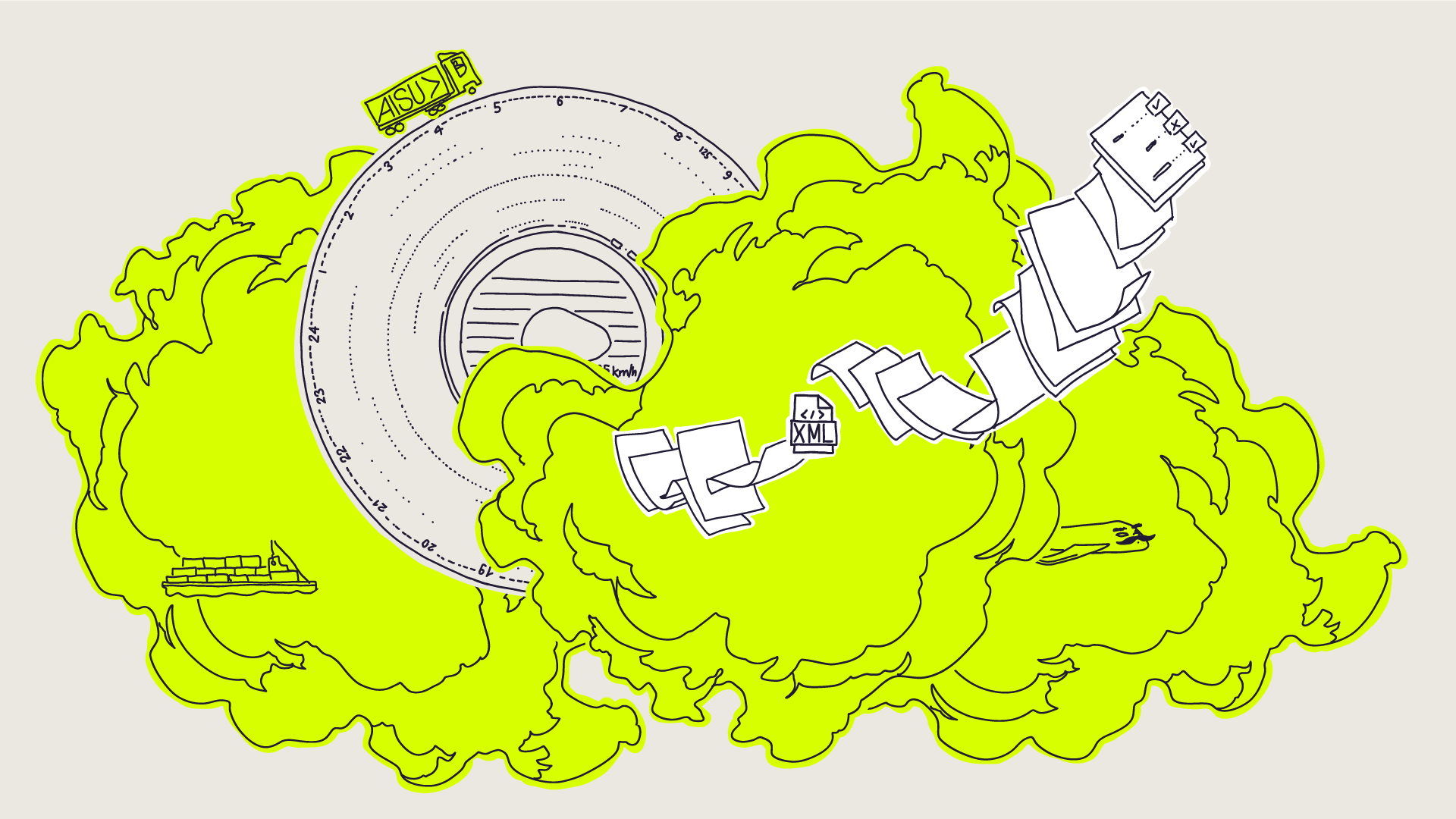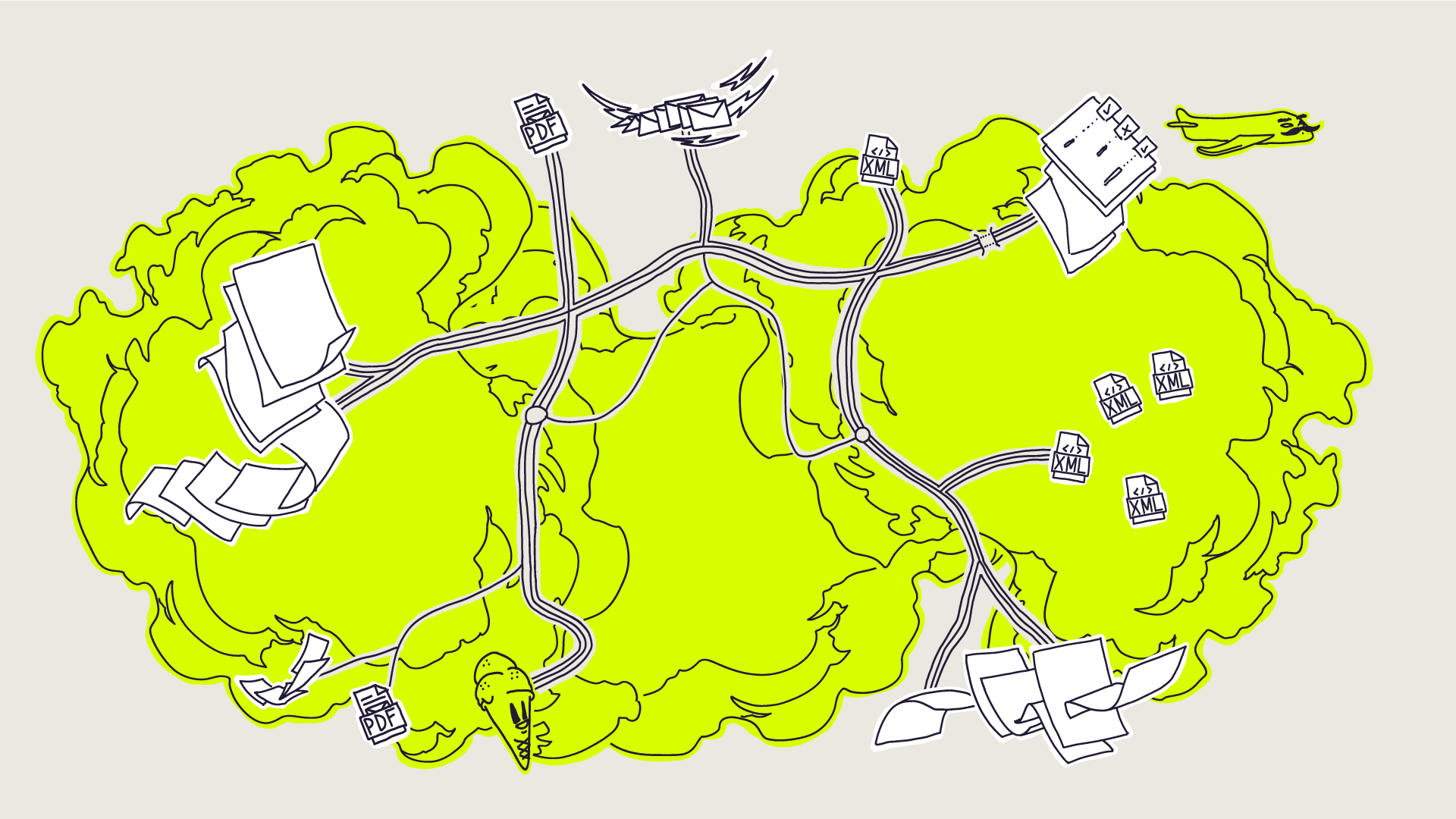Electrifying Invoices
& Engineering the Logistics Documents Evolution
Illustrations in this article by Dominik Heilig / Aisu.StudioResearching for a product owner role at a logistics company, I ended up going down the rabbit hole (or rather a bear's den) looking at the broadness of the topic. What started as a job prep turned into something really exciting, hence I feel the urge to share a wrap-up of my research.
TL;DR
Germany's e-invoice mandate isn't just regulatory compliance - it's accidentally creating the digital backbone for next-generation logistics. When a $10 trillion industry shifts from unstructured PDFs to machine-readable XML data, you get real-time visibility into costs, performance, and cash flows that were previously invisible. Early adopters like DHL and DB Schenker are already seeing reconciliation times drop from weeks to hours. The really exciting part? This same structured data infrastructure solves CSRD sustainability reporting requirements and enables algorithmic dispute resolution that saves 15-20 days per incident. While everyone's focused on AI, there's massive competitive advantage hiding in these "boring" regulatory requirements - especially as global supply chains navigate tariff wars, EV transitions, and geopolitical disruptions that demand rapid adaptation.
The Timeline Reality
Germany's rolling out its E-Rechnungspflicht in stages. Companies need to handle incoming e-invoices by January 2025, then larger businesses (€800k+ turnover) must issue them by 2027, with everyone else following by 2028.
The Numbers Game
The logistics industry moves very serious money - we're talking about a $10 trillion!! global market that's expected to more than double by 2034. Europe handles around $783 billion of that, with Germany contributing about $202 billion. When you think about structured e-invoicing hitting an industry this massive, it's not just about swapping PDFs for XML files.
Beyond the Compliance Checkbox
Logistics companies aren't just preparing for regulatory compliance - they're realizing this forces them to rebuild how they actually operate. Take a freight forwarder handling 50,000+ invoices monthly across different countries. You can't just digitize the same old manual processes when every invoice needs to fit structured formats like XRechnung or ZUGFeRD.
Early Movers in Action
DHL's European network has been piloting structured invoice processing across their cross-border operations, reducing reconciliation time from weeks to hours. Kuehne+Nagel integrated XRechnung directly into their existing transportation management system, creating automatic cost validation against contracted rates. DB Schenker's Germany-Italy corridor now processes freight invoices in real-time, enabling faster payment readiness and reducing working capital lock-up rather than the traditional 30-day payment cycles.
Supply Chain Ripple Effects
The impressive part is how this connects across entire networks. When you've got carriers, customs brokers, and third-party logistics providers (3PLs) all exchanging structured invoice data in real-time, suddenly you can see cost patterns, performance metrics, and cash flows that were invisible before. Instead of waiting weeks to reconcile paper invoices, you get immediate visibility into which routes cost more, which carriers consistently deliver on time, and where cash is tied up in the payment cycle. One shipment with five service providers becomes a data pipeline instead of a paper trail.
The Sustainability Data Connection
Here's where things get really interesting: the Corporate Sustainability Reporting Directive (CSRD) requires detailed supply chain emissions reporting by 2025-2026, and structured e-invoice data provides the transactional foundation needed for accurate Scope 3 emissions tracking. However, invoice data is a foundation, not a full solution - companies still need specialized tools like EcoTransIT World and GLEC Framework, plus life cycle assessment databases, to interpret emission attributes from the structured transaction data.
The EV transformation makes this even more critical. As logistics fleets transition to electric vehicles, companies need granular data to track emissions reductions, validate green supply chain claims, and report on sustainability progress. An e-invoice from an EV delivery service can include battery source verification, renewable energy usage, and precise emission calculations - data that becomes essential for CSRD compliance. Instead of managing two separate digital transformations, forward-thinking companies are building integrated systems where e-invoice mandates create the data infrastructure that sustainability reporting requires.
The Collaboration Angle
Something I found particularly exciting is the Open Logistics Foundation - initiated by the Fraunhofer Institute and supported by "heavy rollers" like Dachser, DB Schenker, and DHL. They're taking an open-source approach to solving these industry-wide challenges. This collaborative model spreads development costs across competitors while creating shared standards that benefit everyone. Instead of each company building proprietary solutions that don't talk to each other, they're pooling resources to tackle complex integration problems collectively.
The Electric Cool-AI Asset Test
The integration work is no joke. Legacy document management systems built for PDFs now need to parse semantic XML data while keeping audit trails and handling digital signatures. International freight forwarders juggle different e-invoice standards - XRechnung for Germany, FatturaPA for Italy, plus traditional formats for non-EU partners.
Understanding the Technical Stack
XRechnung isn't just "XML invoices" - it's a semantic data model that structures every transaction element. Unlike traditional invoices that might describe a "freight charge," XRechnung specifies route segments, carrier identifiers, service classifications, and cost breakdowns in machine-readable format. ZUGFeRD takes a hybrid approach, embedding this structured XML data inside human-readable PDFs, allowing both automated processing and manual review.
Digital signatures add another complexity layer. Every structured invoice requires eIDAS-compliant certificates, creating cryptographic chains of trust from freight forwarder to final recipient. Legacy systems built around email attachments now need certificate validation, timestamp authorities, and audit trails that prove invoice integrity across international borders.
API integration patterns are evolving too. Instead of batch processing invoice files, companies are implementing real-time validation endpoints that verify structured data against transportation management systems, customs databases, and carrier rate tables as transactions occur.
The SME Challenge
While the focus often falls on major players like DHL and DB Schenker, small and medium-sized logistics companies face significantly higher relative challenges. For a regional freight forwarder with 50 employees, upgrading legacy ERP systems and managing IT integration costs can represent a substantial portion of annual revenue. Unlike large enterprises with dedicated IT teams, SMEs often need external consultants and face longer implementation timelines, making early preparation even more critical for smaller players in the logistics ecosystem.
The Enterprise Software Ecosystem
This transformation is happening within an already massive enterprise software market. Manhattan Associates dominates warehouse management with their WMS solutions running in over 1,200 facilities worldwide. Descartes controls route optimization and global trade intelligence, processing millions of shipments annually. SAP's logistics modules are embedded in countless supply chains, while Oracle's transportation management systems handle everything from carrier selection to freight audit. These aren't small players - we're talking about a combined market worth tens of billions, serving companies that collectively move trillions in goods.
The e-invoice mandate isn't just creating compliance headaches; it's forcing major upgrades and integrations across this entire established ecosystem. When Manhattan needs to connect their WMS to structured invoice flows, or when Descartes has to parse XML freight bills instead of PDFs, the ripple effects touch every corner of global logistics. The companies already invested in these platforms need them to evolve quickly, and the software giants are racing to deliver e-invoice capabilities that maintain their competitive moats.
But here's the thing: companies tackling this early aren't just checking compliance boxes. They're building straight-through processing that eliminates the whole invoice-to-payment dance. Real-time financial data integration opens up automatic warehouse releases, predictive cash management, and algorithmic dispute handling by detecting disputes in real-time, automatically catching rate discrepancies like billing errors, auto-resolving simple cases and only escalating on certain thresholds. That could save up to 15-20 days compared to traditional manual dispute resolution cycles.
In a Nutshell
This research showed me that what looks like regulatory housekeeping is actually rewiring how logistics networks operate. When financial transactions become structured data streams instead of document shuffling, you get the foundation for advanced analytics and predictive operations.
The companies treating this as a transformation opportunity rather than a compliance burden are setting themselves up nicely. There's real competitive advantage hiding in these seemingly mundane regulatory requirements.
But Roadbumps Ahead, Drive Carefully
The intersection of logistics complexity, regulatory compliance, and system integration creates plenty of room for innovative solutions. There's substantial value in solving the fundamental data flow problems that keep global trade moving.
Global logistics is navigating tariff wars, blocked shipping routes, sanctions reshaping trade partnerships, and the massive shift from combustion engines to EVs creating new supply chains. When you need to rapidly pivot suppliers due to sanctions, reroute shipments around conflict zones, or onboard new EV component manufacturers, having structured financial data becomes critical for quick decision-making. Companies with real-time visibility into costs, performance metrics, and payment cycles can adapt faster than those still shuffling paper invoices and waiting weeks for reconciliation.
The transformation is already happening - the question is who's going to build the tools that make it work smoothly.
What are your experiences with e-invoicing or digital transformation in logistics? Have you seen benefits or faced challenges? Share your thoughts and let’s continue the conversation in the comments below!
Big thanks to Perry Neumann for your review and feedback! ❤️
Sources & Further Reading (Exerpts)
1. Bundesministerium der Finanzen: E-Rechnungspflicht
2. Precedence Research, Logistics Market
3. McKinsey – Logistics & Supply Chain




